
views
Choosing a Type of Powder
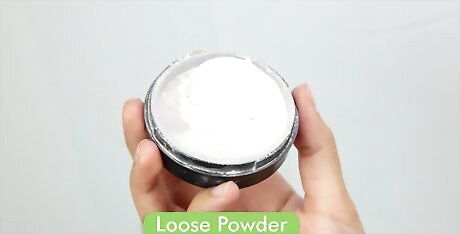
Go with a loose powder for lightweight full coverage. Setting powders can be either loose or compact, but loose powders have finer particles. These finer particles tend to feel lighter on your skin. Get this powder type if you’re hoping to use your powder as a light, uniform coating rather than a second layer of concealer.
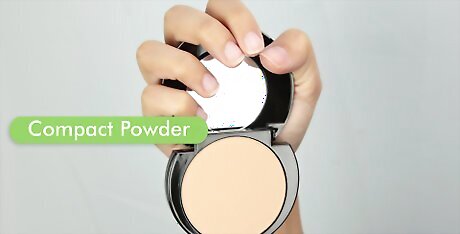
Get a compact powder for touch-ups. Pressed compact powder is denser than loose powder, which makes it great for quick touch-ups throughout the day. It can appear cakey if you apply too much, however. It also contains silicones and waxes that can be irritating, so it may be best not to use this type if you have sensitive skin. For people with normal or dry skin, compact powder is also a great alternative to liquid foundation.
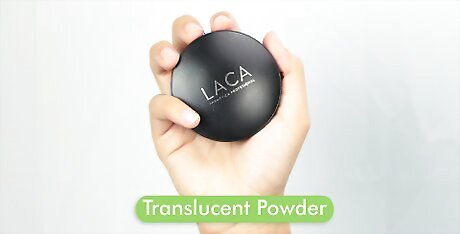
Choose a translucent setting powder to minimize shine. Translucent powders are great for reducing shine that’s caused by oil accumulation on the skin. This may be the way to go if you don’t want to adjust your coloring, but rather hope to improve the texture of your skin by preventing and decreasing oiliness. You can get this type of powder in either loose or compact form, and can apply it over foundation or on your bare skin.
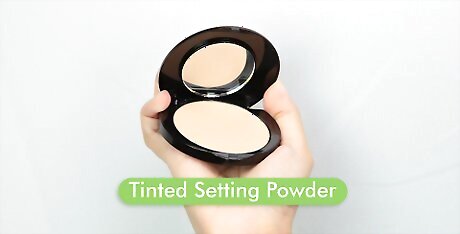
Select a tinted setting powder if you want to even your skin tone. Like translucent powders, tinted powders can be purchased in loose or compact form, and also can be applied to makeup-free skin or over foundation. However, tinted powders help brighten and correct your skin tone, instead of just working to reduce shine. Be sure to pick the right color when buying tinted powder. If you have dry skin or normal skin, match the tinted powder to your skin tone. If you have oily skin, go 1/2 to 1 shade lighter, as the powder will oxidize and darken when it comes in contact with oil.
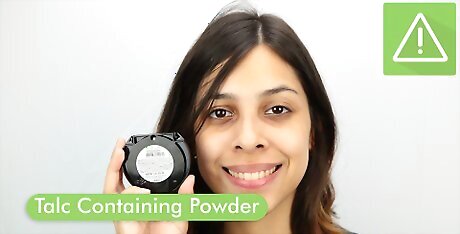
Find a powder that contains talc if your skin is oily. Different setting powders work best with different skin types. If your skin is on the oily side, look for a product that includes talc on its ingredient label. Talc has oil-absorbing properties, so powder that contains it is often the most flattering and beneficial option for those who have oily skin.c

Go with a powder that contains hyaluronic acid if your skin is dry. Check different powder labels to see if they contain hyaluronic acid. Opt for one that does if your skin is on the drier side, as hyaluronic acid will hydrate and moisturize your skin.
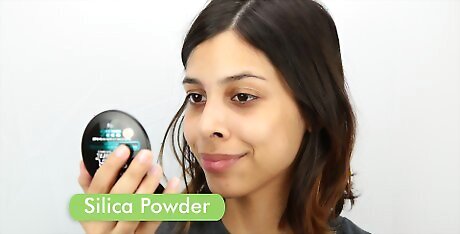
Opt for silica powder if you have normal skin. If your skin isn’t quite oily or dry, this may be your best option. Use a silica powder as your setting powder to ensure a smoother application. Dry skin typically responds well to silica powder too, but it isn’t recommended for oily skin types because it can lead to build-up.
Applying Your Powder
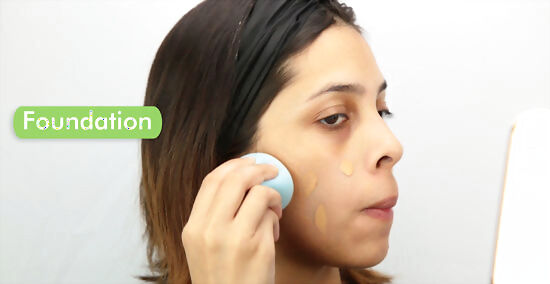
Apply your foundation first. If you want to wear primer and concealer, or if you want to contour your face, be sure to apply those as well. Make sure that everything is blended in well. Hold off on your blush, highlighter, bronzer, and eye makeup for now. Don’t forget to wash your face and apply moisturizer before you put any of your makeup on. Move quickly onto the next step; you want to apply powder while your foundation is still damp.
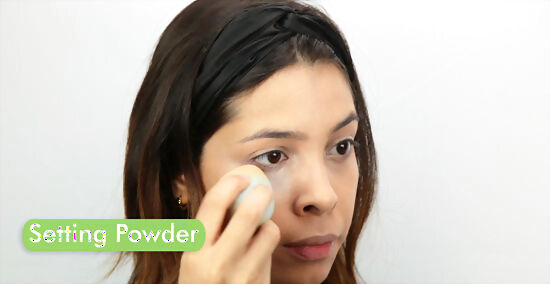
Apply your powder with a makeup sponge, a powder puff, or a powder brush. Pick an applicator based on what you’re hoping to accomplish with your setting powder. If you want to use a lot of product to get full coverage, opt for a makeup sponge. Go for a powder puff if you have oily skin and you want a velvety matte finish. Finally, get a soft, glowy complexion by applying with a powder brush.

Use an appropriate amount of setting powder. The goal is to apply enough powder to give your skin a velvety finish, but not so much that it’s visible to the eye. To accomplish this, make sure that your applicator is evenly coated by dabbing it into the powder and then tapping off the excess. Go light on the powder to get a dewy finish. Go a little heavier on the powder if your skin is oily, or if you want a matte finish.
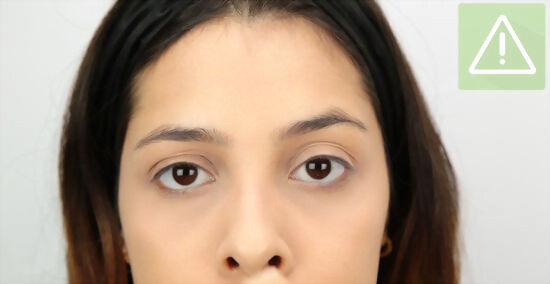
Focus on your t-zone as you apply the powder. To get a seamless, natural look, stay away from the outer edges of your face and apply most of your powder to your t-zone, across the lower part of your forehead and down the bridge of your nose. This is where oil tends to accumulate the most. Do a very light dusting of the powder all over your face, and then apply a little extra powder in your t-zone as needed. Be careful around your hairline, as the powder may be difficult to get out of your hair.

Use a press-and-roll motion to keep your foundation intact. If you’re using a makeup sponge or powder puff, resist the urge to apply your powder by using a wiping motion. Instead, gently press and roll the powder onto your face to avoid moving your foundation and concealer. Brushes tend to allow for lighter application, so you shouldn’t need to worry about this if you’re applying your powder with a brush.

Wait 1-2 minutes before you blend and buff with a fluffy makeup brush. After applying your powder, let it sit on your skin as is for 1-2 minutes. This is called “baking,” and may encourage the powder to set in better. After the time is up, go over your whole face in circular motions with a large, fluffy makeup brush so that everything blends in seamlessly.
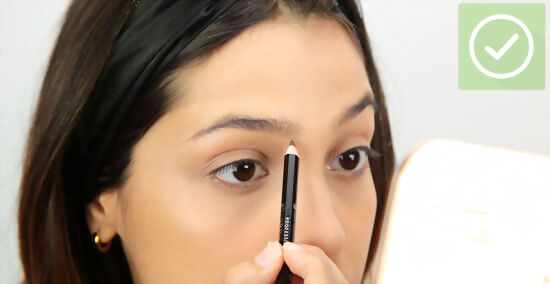
Apply the rest of your makeup. Once you are happy with your coverage, you can apply the rest of your makeup. This includes your blush, bronzer, highlighter, and any eye makeup you want to do. You can also try applying a bit of powder over your blush to blend it or soften the color.
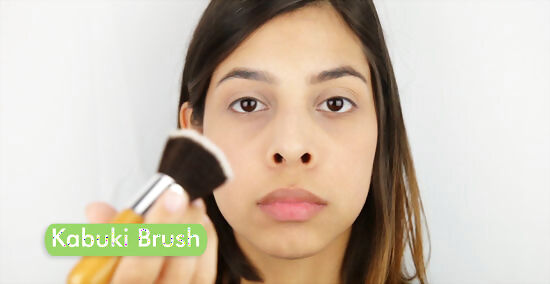
Use a kabuki brush to apply throughout the day. Dab your kabuki brush in pressed powder for touch-ups. This should allow you to get some coverage without applying too much powder. Also, this should make applying on the go easier. Avoid using powder puffs for touch-ups, as they tend to apply too much product and not blend well.
Using Setting Powder in Alternative Ways
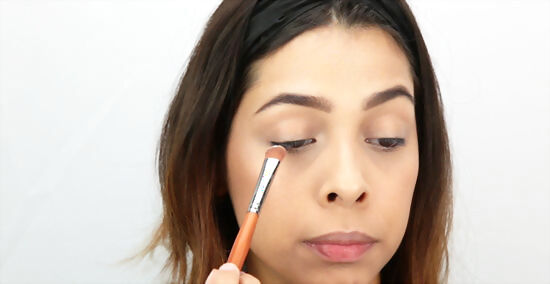
Set your eyeliner with translucent setting powder. While liquid eyeliners can last all day, cream-based pencil eyeliners tend to turn runny as the day goes on. You can help your eyeliner stay put by dusting translucent setting powder over it with a thin brush. If you like to line your bottom lashes, apply the translucent setting powder first, then the eyeliner, then more powder.

Make your matte lipstick last longer with translucent setting powder. Apply your lip liner and matte lipstick as you usually would. Blot with a tissue to remove excess product and prevent clumping. Use a soft, fluffy powder brush to dust a thin layer of translucent setting powder over your lipstick to set it. It’s best not to put powder on glossy or shimmery lipsticks, because the powder will make the lipstick clump or look duller.
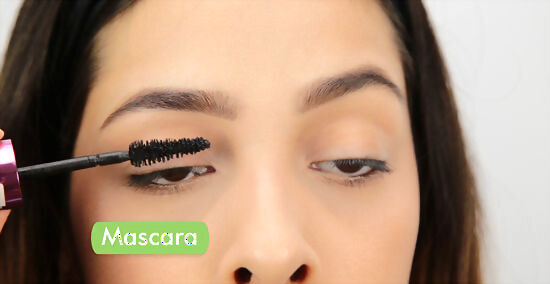
Volumize thin lashes with mascara and pressed translucent powder. Apply a coat of mascara first, then dust your lashes with an eyeshadow brush and translucent setting powder. Follow up with another coat of mascara.

Dust setting powder under your eyes to catch any excess eyeshadow. Before applying eyeshadow, eyeliner, or mascara, brush a heavy coating of powder over the area below your eye and above your cheekbone. After finishing your eye makeup, use a clean brush to dust the setting powder away. Any shadow that may have fallen off during application will stick to the setting powder, so you can simply brush it away with the powder. It’s typically best to use a translucent setting powder for this, but you can use tinted setting powder too.
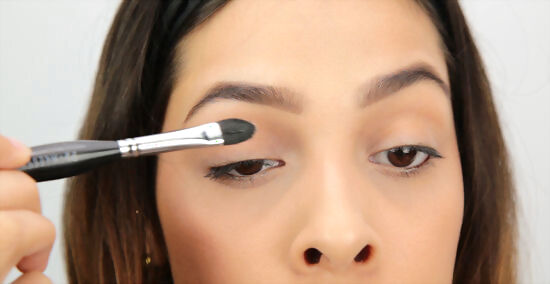
Reduce shine on your eyelids with concealer and translucent powder. If you have oily eyelids, apply some concealer to them. Then, use an eyeshadow brush to dust them with translucent setting powder. This should soak up any excess oil and brighten up your eyes.
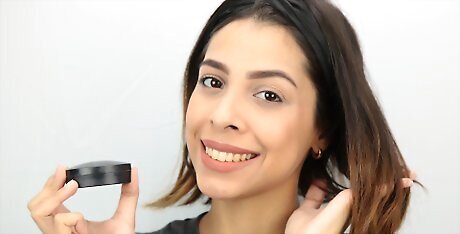
Substitute dry shampoo with setting powder. Setting powder tends to do a good job of absorbing the excess oil that’s not just on your skin, but also in your hair. This is essentially what dry shampoo does. If your hair is feeling a little greasy and you are out of dry shampoo, sprinkle some translucent setting powder onto the roots. If you have light-colored hair, use regular powder. If your hair is darker, use a bronze-tinted powder to help it blend in. Finger comb your hair to help distribute the powder through the roots.
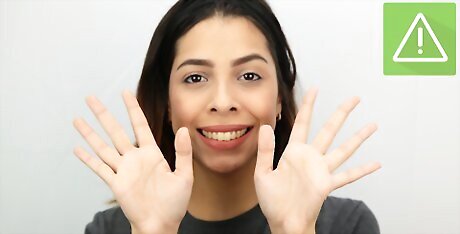
Reduce sweating or chaffing on your hands and feet with translucent powder. Apply setting powder to your palms or the underside of your feet to help absorb excess sweat in these areas. Dust setting powder onto your feet with a powder brush or powder puff before slipping into a pair of heels to prevent chaffing.











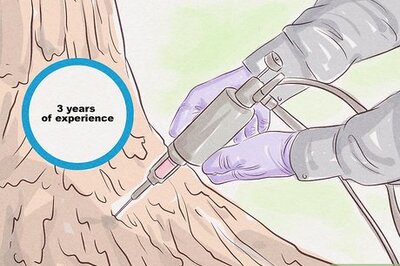







Comments
0 comment